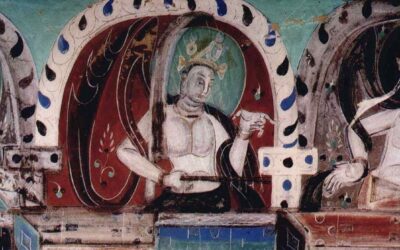THE LION-DANCE AS RELIGIOUS DANCE
The lion-dancers first appeared in China under the Tang dynasty (a.d. 618-906), and made their debut at the court of the kings of Tibet about the same time. The lion-dancer represents a form of the Indian mime or burlesque juggler, who originally exhibited tame lions and trained monkeys, wandering from place to place, entertaining crowds at fairs and religious festivals.
Along the high roads of Shaanxi Province in northern China are still to be seen numerous square pillars surmounted by figures of lions, monkeys, and stage-fools. In some cases the monkey squats on the lion’s back, in others it is the fool stretching out his hands into the animal’s jaws, who sits astride the lion’s back. He wears the characteristic, spacious, conical fool’s cap, the tip of which falls down in front, his countenance expressing a somewhat melancholy, but humorous good nature.
The mimes, at first, simply covered their faces with a lion mask, and it is an interesting coincidence that the European harlequin also frequently appears with the mask of the lion; for the lion had developed into the emblem of the buffoon.
Live lions were not obtainable in China and Tibet, and as their transportation from India was a costly matter, the strolling mimes soon hit upon the expedient of representing the lion’s body by a covering of cloth and using two men instead of one,—one carrying the head; the other, the hind portion; the trousers of each forming the animal’s feet.
Buddhists recognize the lion as the emblem of Buddha, who in the sacred texts is referred to as “he with the lion’s voice.» The lion is regarded as the protector of his religion; hence huge statues of lions are generally to be found in front of Buddhistic temples. In this way the lion-dance came to be looked upon also as a demon-expelling ceremony.
In Peking companies of acrobats have been organized to cultivate this specialty. The blue and yellow lions perform a contra-dance, displaying an astounding skill and agility; the eyeballs, tongue, jaws, ears, and tail in rapid motion, while the bells of the neck-collars tinkle to the accompaniment of gongs.
The lion being credited with a fondness of playing with a ball, the main feature of the performance is the pursuit by the lions of an enormous ball which is thrown in front of them or across their path. They will even leap on to the roof of a one-storied house, and jump down from there into the courtyard.
En: Berthold Laufer. Oriental Theatricals. Field Museum of Natural History. CHICAGO, 1923
About me: I have spent 30 years in China, much of the time traveling and studying this country’s culture. My most popular research focuses on Chinese characters (Chinese Characters: An Easy Learning Method Based on Their Etymology and Evolution), Matriarchy in China (there is a book with this title), and minority cultures (The Naxi of Southwest China). In my travels, I have specialized in Yunnan, Tibet, the Silk Road, and other lesser-known places. Feel free to write to me if you’re planning a trip to China. The travel agency I collaborate with offers excellent service at an unbeatable price. You’ll find my email below.
Last posts
The Lost Mythology of Ancient China
The Lost Mythology of Ancient China Reconstructing the mythology of ancient China is a painstaking task that tries to characterize some legendary figures and situations based only on the few sentences about them found in later works by philosophers and historians. The...
How a Eunuch Was Created in 19th-Century China
How a Eunuch Was Created in 19th-Century China A wealthy eunuch would purchase a boy from a poor family. This boy had to be between seven and ten years old. He would be kept confined for two weeks and subjected to a very strict diet; he ate little. Use of...
Dunhuang in the Silk Road
Dunhuang in the Silk RoadDunhuang is a city in the middle of the desert. Over its 2,000-year history, it has always been the last Chinese outpost before reaching the Western Regions—those kingdoms more or less dominated by the imperial regimes, yet showing customs so...







